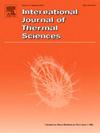Numerical and experimental investigation of heat transfer and flow in oscillating laser dual-wire deposition
IF 4.9
2区 工程技术
Q1 ENGINEERING, MECHANICAL
International Journal of Thermal Sciences
Pub Date : 2025-01-25
DOI:10.1016/j.ijthermalsci.2025.109741
引用次数: 0
Abstract
The oscillating laser heat source covers a large area, effectively reducing peak temperature and temperature gradient, while dual-wire additive manufacturing improves wire melting efficiency and forming quality. Therefore, this paper addresses the issues of low wire melting efficiency and poor forming quality in aluminum alloy wire melting additive manufacturing. Using 5A06 aluminum alloy as the research subject, a process combining oscillating laser and dual-wire techniques is proposed. Experimental and simulation analyses are conducted to evaluate this process, leading to the development of a coupled thermal-fluid model for the oscillating laser dual-wire additive manufacturing. Simulations of the temperature and flow fields are performed for various oscillation paths, frequencies, and amplitudes. The results demonstrate that, under the circular oscillation mode, the heat distribution within the molten pool is more uniform, the flow field remains stable, and the overall forming quality is superior. As the oscillation frequency increases, the width of the deposited layer decreases, while its height increases. Additionally, the melt pool's range, depth, and peak temperature exhibit a negative correlation with the oscillation frequency. Increasing the oscillation amplitude leads to a reduction in the melt pool's range, depth, and peak temperature, with the most stable flow and pool condition observed at an amplitude of 1.5 mm. This research provides both theoretical insight and guidance for the optimization of the oscillating laser dual-wire additive manufacturing process for aluminum alloys.
求助全文
约1分钟内获得全文
求助全文
来源期刊

International Journal of Thermal Sciences
工程技术-工程:机械
CiteScore
8.10
自引率
11.10%
发文量
531
审稿时长
55 days
期刊介绍:
The International Journal of Thermal Sciences is a journal devoted to the publication of fundamental studies on the physics of transfer processes in general, with an emphasis on thermal aspects and also applied research on various processes, energy systems and the environment. Articles are published in English and French, and are subject to peer review.
The fundamental subjects considered within the scope of the journal are:
* Heat and relevant mass transfer at all scales (nano, micro and macro) and in all types of material (heterogeneous, composites, biological,...) and fluid flow
* Forced, natural or mixed convection in reactive or non-reactive media
* Single or multi–phase fluid flow with or without phase change
* Near–and far–field radiative heat transfer
* Combined modes of heat transfer in complex systems (for example, plasmas, biological, geological,...)
* Multiscale modelling
The applied research topics include:
* Heat exchangers, heat pipes, cooling processes
* Transport phenomena taking place in industrial processes (chemical, food and agricultural, metallurgical, space and aeronautical, automobile industries)
* Nano–and micro–technology for energy, space, biosystems and devices
* Heat transport analysis in advanced systems
* Impact of energy–related processes on environment, and emerging energy systems
The study of thermophysical properties of materials and fluids, thermal measurement techniques, inverse methods, and the developments of experimental methods are within the scope of the International Journal of Thermal Sciences which also covers the modelling, and numerical methods applied to thermal transfer.
 求助内容:
求助内容: 应助结果提醒方式:
应助结果提醒方式:


